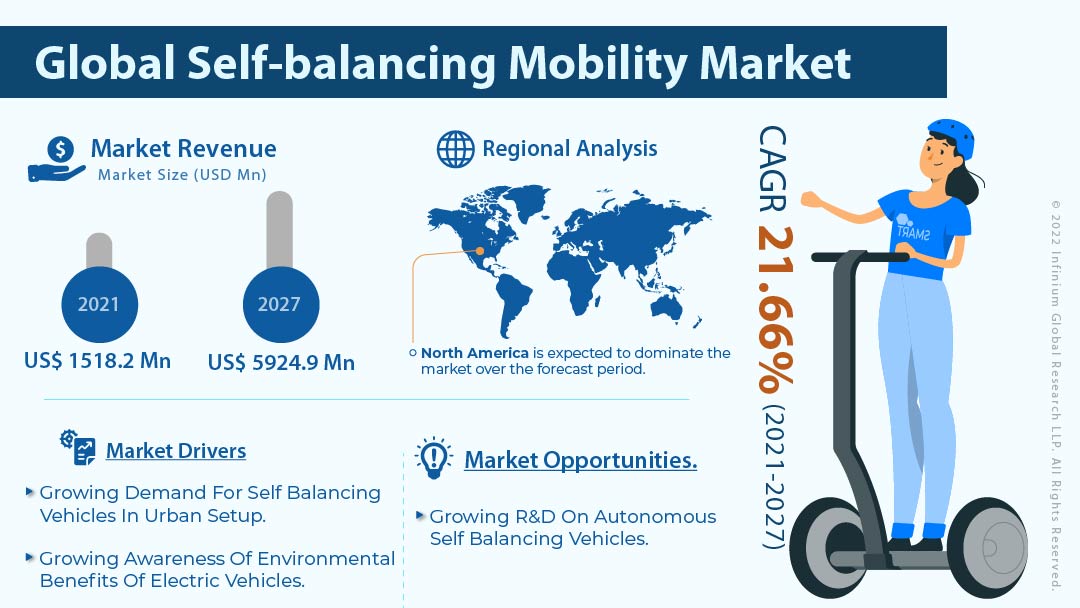Self-balancing Mobility Market (Type - Single Wheeled, and Double Wheeled; Mobility Type - Scooter, Bikes, Hoverboards, and Others; Components - Electric Motor, Digital Sensors, Gryroscope, and Control Board; End Use - Personal, and Commercial): Global Industry Analysis, Trends, Size, Share and Forecasts to 2027
A recent report published by Infinium Global Research on the self-balancing mobility market provides in-depth analysis of segments and
sub-segments in the global as well as regional self-balancing mobility market.
The study also highlights the impact of drivers, restraints, and macro
indicators on the global and regional self-balancing mobility market over the
short term as well as long term. The report is a comprehensive presentation of
trends, forecast and dollar values of the global self-balancing mobility market.
According to the report, the global self-balancing mobility market is projected
to grow at a CAGR of 21.66% over the forecast period of 2021-2027.
Market Insight
The revenue generated by the market was approximately USD 1518.2
million in 2020 and is expected to reach approximately USD 5924.9 million in
2027. Self-balancing mobility can be defined as a single-person self-balancing
transporter with a two-or one-wheeled platforms. It steers via a self-balancing
gyroscopic mechanism that changes directions based on which way the rider
leans, unlike conventional vehicles. Digital sensors and one or two electric
motors are used in this novel and increasingly popular mode of urban mobility.
The wheel is regarded as one of the greatest ground-breaking technologies in
human history. When we see self-balancing motorized mobility vehicles now, we
feel like we're in the future. They're small, easy to use, and agile, and the
tilt-to-control function is really sensitive. These self-balancing mobility
solutions are fast gaining popularity among young consumers as they offer easy
mobility and are increasingly becoming part of the fashionable lifestyle of
young consumers.
According to Our World In Data organization, approximately 7
billion people are expected to be living in urban areas, and according to the
World Bank, over 56% of the total world population was living in urban areas in
2020. The strong growth in per capita income and the standard of living of
people in urban areas has made self-balancing mobility both desirable and
affordable. The demand for self-balancing mobility is growing among people
living in urban areas. These self-balancing mobility solutions are preferred in
closed urban environments such as commercial spaces, educational and research
institutions, housing societies, and others. The other factor driving the
growth of the market is the growing awareness of the environmental benefits of
self-balancing mobility. Self-balancing vehicle types such as hoverboards and
scooters are powered by batteries and run on an electric motor. Hence, the
carbon emissions are zero. They are being eyed as an environmentally
sustainable personal transport solution, and their popularity has rapidly
soared among consumers due to their low prices and eco-friendly nature. The
growth of the market may be restrained as the batteries powering self-balancing
mobility solutions have a limited range and need to be changed frequently.
Nevertheless, new growth opportunities are emerging as R & D of autonomous
self-balancing mobility solutions is going on in full swing.
North America is expected to dominate the market over the forecast
period. North America is the top product consumer in the market. The region is
the top destination for manufacturers from around the world to sell their
self-balancing mobility products. The high demand for self-balancing mobility
products is due to a number of factors. North America has an advanced urban
infrastructure where self-balancing mobility solutions can be easily used.
Another factor is the supporting infrastructure, such as charging points, that
is being created on a large scale. High spending power due to high disposable
income and a high standard of living are the factors that are also supporting
the growth of the market in the region. Along with personal self-balancing
mobility products, the demand for commercial self-balancing mobility solutions
is growing strongly as global corporate houses and educational institutions are
adopting these eco-friendly mobility solutions. Also, the supply chain and
distribution network are strong because the market is strong in North America.
Asia-Pacific is expected to grow at the fastest pace as the region is one of
the major manufacturers in the market.
Segment Covered
The report on the global self-balancing mobility market covers
segments such as type, mobility type, components, and end use. On the basis of
type, the sub-markets include single wheeled, and double wheeled. On the basis
of mobility type, the sub-markets include scooter, bikes, hoverboards, and
others. On the basis of components, the sub-markets include electric motor,
digital sensors, gryroscope, and control board. On the basis of end use, the
sub-markets include personal, and commercial.

Companies Profiled:
The report provides profiles of the companies in the market such
as Inventist, Inc., Segway, Inc., Airwheel Holding Limited, Ninebot Inc.,
Hangzhou Halsun Technology Co., Ltd., IPS Electric Unicycle Co., Limited,
HoverRobotix, Freego High-Tech Corporation Limited, Oxboard B.V., and
Inmotion Technologies Co., Ltd..
Report Highlights:
The report provides deep insights into the demand forecasts,
market trends, and micro and macro indicators. In addition, this report
provides insights into the factors that are driving and restraining the growth
in this market. Moreover, The IGR-Growth Matrix analysis given in the report
brings an insight into the investment areas that existing or new market players
can consider. The report provides insights into the market using analytical
tools such as Porter's five forces analysis and DRO analysis of the self-balancing
mobility market. Moreover, the study highlights current market trends and
provides forecast from 2021-2027. We also have highlighted future trends in the
market that will affect the demand during the forecast period. Moreover, the
competitive analysis given in each regional market brings an insight into the
market share of the leading players.
